Champasak What To Visit? Top 09 Best Temples In Champasak Town Laos

Laos, a peaceful country steeped in Buddhist culture, is an ideal destination for those who appreciate tranquility and cultural heritage. When visiting Champasak, a region rich in tradition, be sure to explore its renowned temples and pagodas. Join Autour Asia as we discover and highlight top best temples in Champasak Town, each preserving the unique spiritual and historical values of this land. In this article, we recommend two famous Champasak temples and provide suggestions for other must-visit temples in Champasak that are also worth your attention.
Before we begin, let’s clarify a common misconception among tourists: Pakse and Champasak are often confused, but they are actually two different districts (Muang) within Champasak province. In this article, we focus on the Champasak temples, in southern Laos.
Table of Contents
1. Vat Phou Temple (Wat Phou)
- Address: Muang Champasak, Laos
- Google Map: https://maps.app.goo.gl/VQV64VrcEp2vCyFX7
Vat Phou, located in Champasak in southwest Laos, was once a major center for Hinduism dedicated to the worship of Shiva. In 2001, it was recognized as a UNESCO World Cultural Heritage site. With over a thousand years of history and remnants of ancient civilization, this temple has become one of the good places to visit in Champasak.
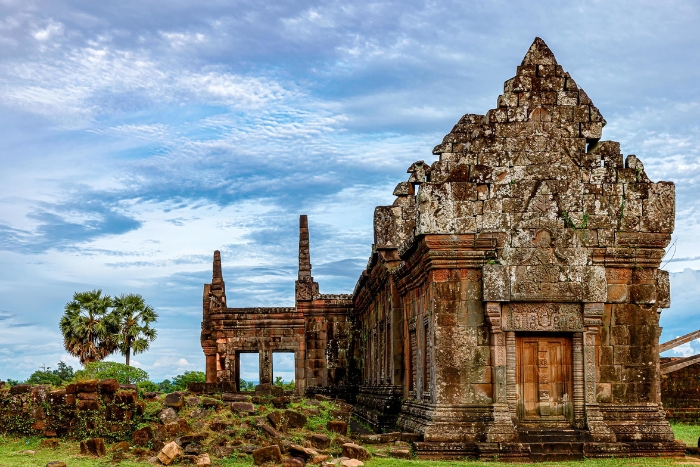
According to Lao historians, this Champasak Temple dates back to the 5th century, making it the oldest temple in Laos and an important hub for Hindu worship. Interestingly, Lao legends and historical records suggest that it was originally dedicated to the god Badhecvara and built between the 5th and 7th centuries. The area also housed Crethapura, the first capital of the Chenla Kingdom. Archaeologists have discovered that there was a road connecting Vat Phou Temple to the Angkor capital, around 100 km away. By the 13th century, Vat Phou became a center for Theravada Buddhism, a role it continues to play today while preserving the historical and cultural heritage of Laos.
For Laotians, this Champasak temple holds even greater spiritual significance due to its unique location. It rests against Elephant Mountain, facing the legendary Mekong River. At the top of Elephant Mountain, a natural stone formation resembles a giant linga, symbolizing the god Shiva. The plains below, once the capital of Shrestapura in Cambodia, represent the ancient city’s grandeur. Phou Kao Mountain symbolizes the god Merum, while the Mekong River below represents the fertile lands central to rice cultivation.
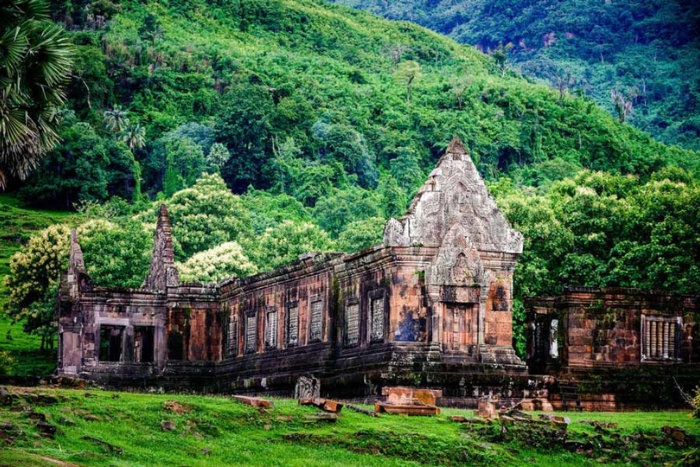
What to visit in Champasak? Vat Phou was constructed between the late 10th and early 11th centuries, predating much of the Angkor complex, which dates from the 12th century with later additions extending into the 14th century. Given its older history and significant archaeological value, this Champasak temple is considered a source of pride for the Lao people.
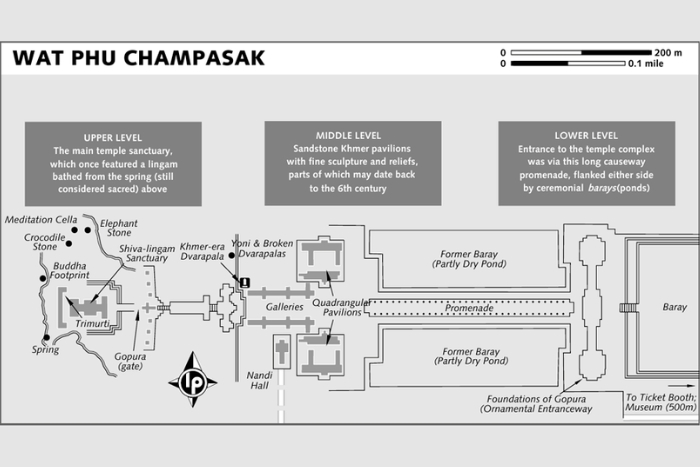
The architectural splendor of Khmer and ancient Hindu influences gives Vat Phou Temple a mysterious allure, drawing visitors with its distinctive lines and patterns. The site is renowned for its intriguing features, such as crocodile carvings, lingams atop mountains, and serpentine steps. That is why visiting Vat Phou becomes one of the best answers to the question: what to do in Champasak? At the entrance of Vat Phou, one of the best temples in Champasak, an ancient museum houses a rich cultural heritage. This temple showcases over 100 intricately carved stone artworks, including reliefs and statues of Hindu deities, reflecting a strong Indian artistic style. Although the main gate of the museum is damaged, it still displays delicate reliefs of Indian gods.
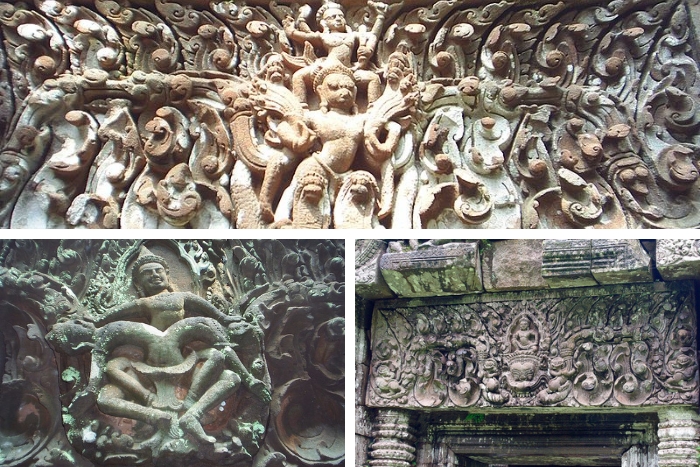
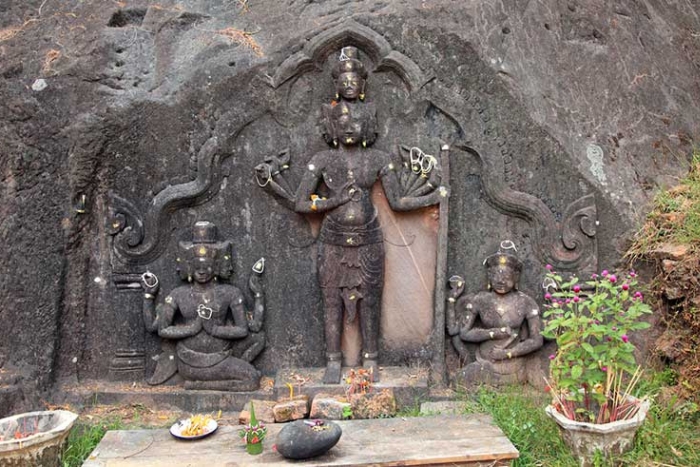
What to see in Champasak? From the main gate, a straight road leads to two temples perched on a high mound, facing east. Rows of stone pillars shaped like Lingas—symbols of Shiva—line both sides of the road. The pavement of flat stones adds to the road's majestic and solemn atmosphere. At the end of the road, there are two main temples facing the East, located symmetrically on a high mound. The two main temples were built from a special type of stone that has been restored to preserve its original beauty. To reach the upper temple area halfway up the mountain, you’ll need to climb numerous stone steps, flanked by tall round pillars on both sides. After ascending 194 steps, you’ll arrive at the top, where the main temple, Vat Phou, stands before you.
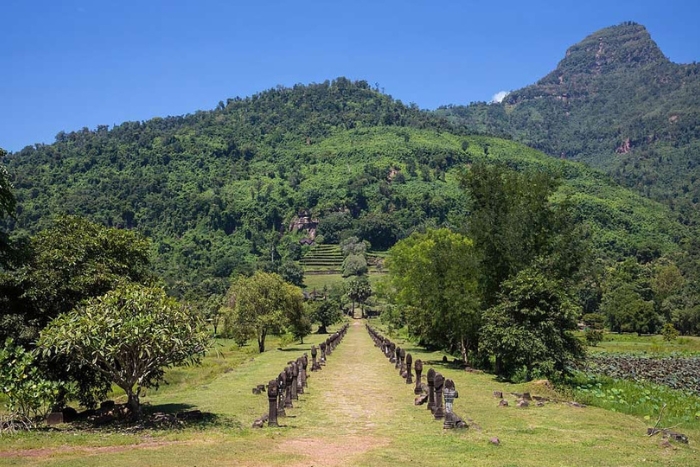
The elevated location offers sweeping views of the lowlands below, extending almost to the Mekong River.
As you explore the area, look out for:
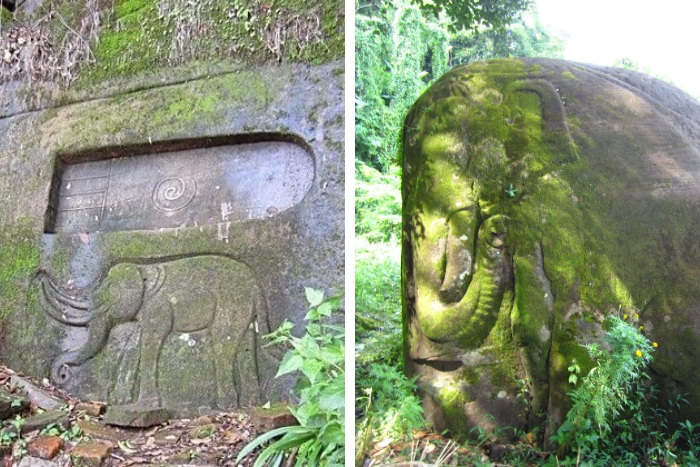
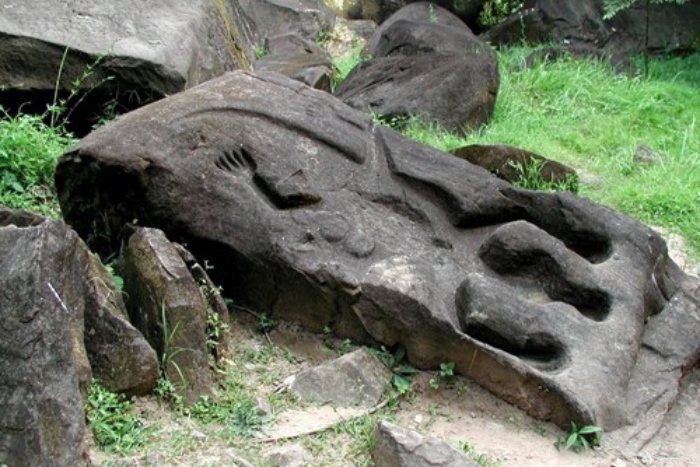
Vat Phou Temple features a unique architectural design, composed of large round upright stones intricately carved with elaborate patterns. Outside the temple, massive stone statues symbolize divine power and authority.
The remarkable ingenuity and dedication of the artisans who transported and assembled these massive stone blocks make this Champasak temple a stunning architectural masterpiece perched atop the mountain.
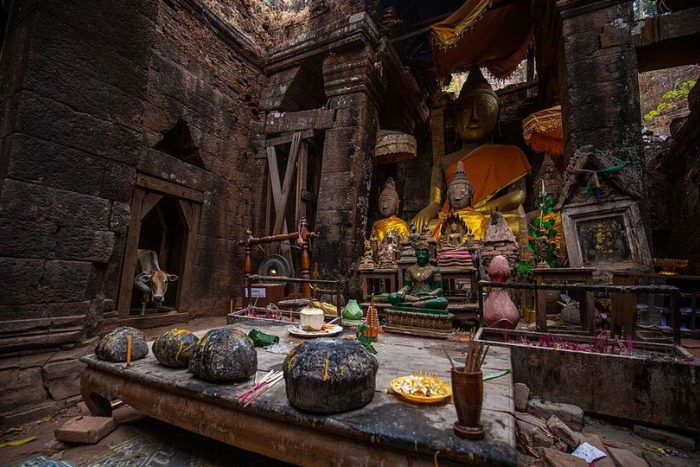
Despite centuries of existence, Vat Phou still echoes ancient civilization with its sandstone temples and Southern Buddhist pagodas. It attracts both domestic and international tourists with its majestic architecture and spiritual mystique. Although, currently, only the relic remains in the area west of the Mekong River, south of Pakse, Vat Phou Temple is still considered one of the places preserving the cultural and historical values of Laos. Recognized as a UNESCO World Heritage site, it continues to captivate visitors with its grandeur and historical significance. It is also one of the top answers to the question, "What to visit in Champasak Town?"
Customer review by Thinh Nguyen (2023) on Google Maps:
"Vat Phou, the oldest temple in Laos, over 1,000 years old, is a must-visit for its unique architecture and rich history. Known as the "land of a million elephants," Laos offers a captivating cultural experience, and Wat Phou stands out as a highlight. Exploring Vat Phou, one of the best temples in Champasak, lets you connect with the past through its storied stones and distinctive design."
This article may be of help to you: How To Get A Laos Visa?
2. Wat Tomo, one of the best temple in Champasak Town
- Address: Muang Champasak, Laos
- Google Map: https://maps.app.goo.gl/WUDTztCwQRKivLcT6
Wat Tomo, also known as Wat Oum Moung, is an ancient Angkorian temple nestled in the Champasak province of Laos. Predating Angkor Wat, this Khmer temple was part of the vast Angkorian civilization. Located about 10 kilometers north of Champasak town, it remains a hidden archaeological gem.According to Google Maps, this is also one of the famous tourist attractions in Champasak.
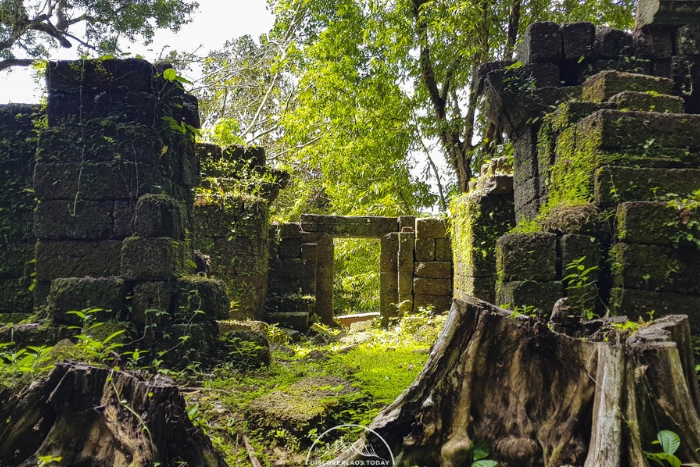
Dedicated to the goddess Rudrani, the wife of the Hindu god Shiva, this Champasak Temple stands near a small river of the same name, which flows into the Mekong. The ruins date back to the 7th-9th century, contemporaneous with the famous Vat Phou Temple, although the latter had not yet been magnificently rebuilt.
By the 12th-13th century, during the height of the Khmer Empire, King Yasovarman I had Wat Tomo restored, with 102 large and small pagodas and towers, as indicated by inscriptions from that era. However, as the Khmer dynasty declined, this Champasak temple fell into disrepair, and the fertile lands along the Mekong contributed to its gradual obscurity.
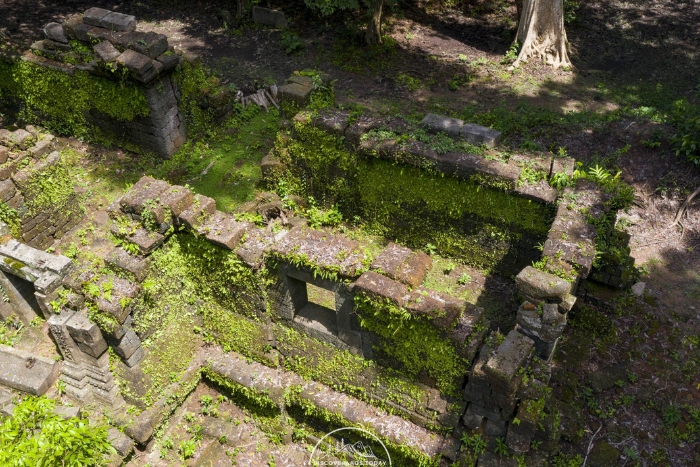
Where to visit in Champasak Town? This two-tiered temple is hidden deep within the jungle lining the Mekong River, shaded by towering trees. Ancient trees, large enough to require several people to embrace, now envelop and grow on piles of gray rocks—the remnants of the ancient temple. Among the ruins, you'll find various structures in different states of decay and several Khmer religious sculptures depicting Hindu gods.

The ruins include an entranceway bordered by lotus-bud carvings, like those found at Vat Phou Temple, and two crumbling gopura (ornate entrance ways), one still partially standing. Several lintels and other sandstone carvings are displayed on rocks beneath towering dipterocarp trees, but the best art from this site is in the Wat Phu Exhibition Hall, including an unusual lingam-style stone post on which two faces have been carved. It's unusual because mukhalinga usually have four mukha (faces), while most ordinary linga have no face at all. The white building at the heart of the site houses a bronze Sukhothai-style Buddha.
The forest and excessive moss do give it a 'lost' feeling. Unlike the more famous Vat Phou nearby, Oum Moung Temple remains largely undiscovered, offering a tranquil and contemplative atmosphere for those who visit.
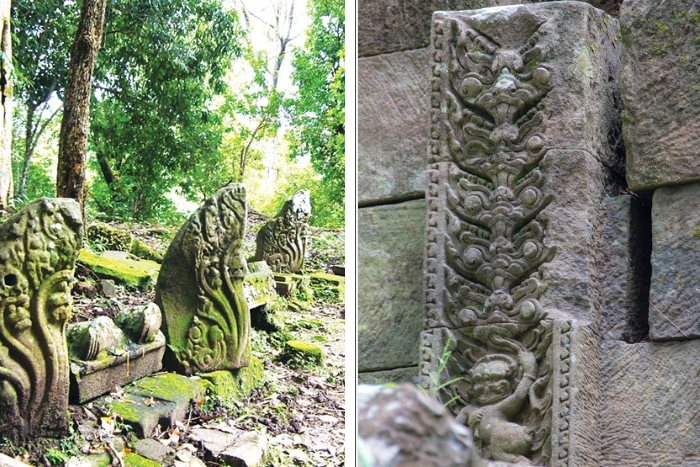
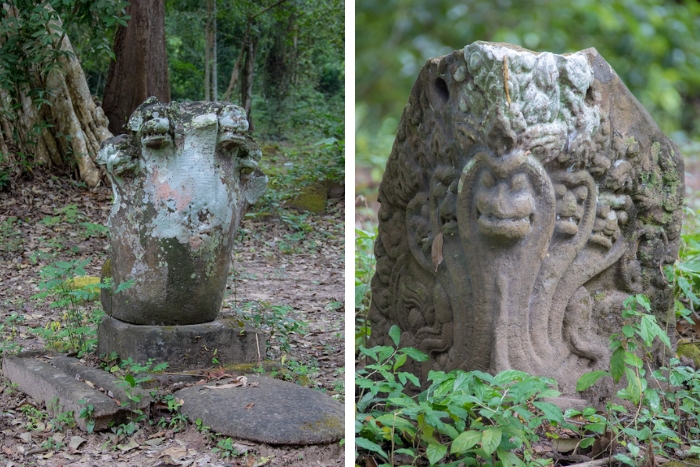
The temple's remnants, including intricate carvings and stone structures, blend seamlessly with the surrounding jungle, showcasing the region's rich historical significance. For those seeking a peaceful, crowd-free experience of ancient ruins, the question is, "Where to visit in Champasak Town?" Visitors will find Wat Tomo mostly deserted, allowing for leisurely exploration of the moss-covered ruins. Reaching the site requires a modest hike, adding an adventurous touch and letting visitors fully immerse themselves in the natural beauty of Champasak.
Customer review by Sprookjesachtig! (03/2020) on Tripadvisor:
"We reached Wat Tomo by scooter from Champasak, with a scenic boat ride along the way. The site is easy to find with clear signs. Entry is 10,000 LAK pp. The temple is tucked in a quiet forest, with 3 clear signs : the marker stone pedestal, irrigation system, and a terrace wall by the Huay Tomo river. Unlike the main entrance wall, this area has some intricately carved door frames. This Champasak Temple s a peaceful spot with no crowds, just the sound of birds and grazing cows."
3. Another Champasak Temple to visit: Top good places to visit in Champasak
Beyond the well-known Champasak temples, here are a few other sites worth exploring:
a. Wat Muang Kang
What to do in Champasak? Visiting Wat Muang Kang temple is one of best indispensable activities in Champasak trip. The oldest active temple in Champasak, dates back to the 19th century and showcases a unique blend of architectural influences from Burma, Cambodia, France, Laos, and Vietnam. Located about 5 km south of town along the Mekong, this Champasak temple features a striking Thai-style ubosot (ordination hall) and a rare hŏr tąi (Tripitaka library) with elements of Lao, Chinese, Vietnamese, and French-colonial design. The damaged but beautiful tower is said to hold Buddha images, with local legends claiming it channels a mystic light to the holy mountain of Wat Phu. The village of Muang Kang is also known for its traditional bamboo weaving.
- Address: Wat Muang Kao, Laos
- Google maps: https://maps.app.goo.gl/b1FBzhJ2PJXtaaAy5
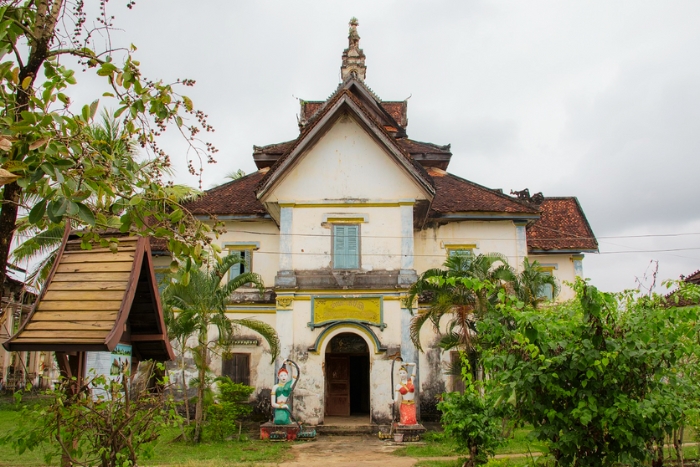
b. Wat Phone Pang
The charming Buddhist temple of Wat Phone Pang, located in Muang, Laos, near Pakse on the banks of the Mekong River, is adorned with gilded motifs and Buddha reliefs. At sunset, the temple and its surrounding community are bathed in a warm glow, enhancing its serene beauty.
- Address: Muang Champasak, Laos
- Google maps: https://maps.app.goo.gl/tvLQXhE1iAvYNNaN9
Additional Temple Suggestions in Champasak:
c. Wat Pho Xay
- Address: Muang Champasak, Laos
- Google maps: https://maps.app.goo.gl/pSyW7E8kJHMkFw3YA
d. Wat Muang Saen
- Address: Muang Champasak, Laos
- Google maps: https://maps.app.goo.gl/UqQqy4fUAPbCc2pp9
e. Wat Yuttitham Thararam (วัดยุติธรรมธรทราราม in Laos)
- Address: Muang Champasak, Laos
- Google maps: https://maps.app.goo.gl/fup6C5SjzZBQ6Hxs8
f. Wat Thong
- Address: Muang Champasak, Laos
- Google maps: https://maps.app.goo.gl/GDnHU8kfjBsBUVJ86
g. Ban Nongte Temple
- Address: Ban Houayna, Laos
- Google maps: https://maps.app.goo.gl/m2CQfkFj8PPAeBas5
What to do in Champasak? Here are key insights on the top 09 best temples in Champasak, curated by AUTOUR ASIA, a Laos Tour agency. Which of these temples would you explore first? Choose your favorite, capture stunning memories, and remember to dress modestly when visiting these sacred sites!
Maybe you want to know more:
>Things To Do in Champasak Province
> Champasak Travel Guide
> Laos in two weeks
> Laos Packages Tours
When in Laos, don't miss the temples in Luang Prabang, the Kuang Si Waterfalls, the landscapes of Vang Vieng, and the Plain of Jars. Mekong River cruises and the Bolaven Plateau are also highlights worth exploring. Laos offers a unique blend of cultural heritage, natural beauty, and adventure that should not be overlooked.
You can explore must-see attractions in Vientiane or Champasak Province for more experiences tailored to your interests.
When visiting temples in Laos, dress modestly, covering shoulders and knees. Remove shoes before entering. Avoid touching or turning your back to Buddha images, and don’t sit or stand higher than monks. Always ask for permission before photographing them. Respect the sacred space by keeping your head lower than religious figures and refraining from loud or disruptive behavior. These guidelines ensure respect for local customs and traditions. You can refer to some best and famous temples in Vientiane, Laos
For Laos, 7-10 days is typically enough for a fulfilling visit. However, if you want a comprehensive experience covering both cultural sites and nature spots, 14 days allows for a complete journey from north to south.
For more itinerary details, explore the Laos Packages Tours by AUTOUR ASIA
Related travel guide
Other similar articles
CUSTOMIZABLE BY LOCAL EXPERTS
Personalized trip at the original price!
REFUND GUARANTEE
We believe in our work and promise to give you money back.
GOOD PRICE / QUALITY
95% satisfied more than expected!
24/7 LOCAL SUPPORT
We are always available online to provide assistance at any time.
Most read articles
Autour Asia is highly recommended on
Embracing the mission of "Satisfied more than expected" and providing authentic experiences, we have received numerous recommendations on reputable travel forums:























